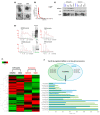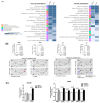Serum-Derived Exosomal MicroRNA Profiles Can Predict Poor Survival Outcomes in Patients with Extranodal Natural Killer/T-Cell Lymphoma
- PMID: 33261029
- PMCID: PMC7761501
- DOI: 10.3390/cancers12123548
Serum-Derived Exosomal MicroRNA Profiles Can Predict Poor Survival Outcomes in Patients with Extranodal Natural Killer/T-Cell Lymphoma
Abstract
Exosomes containing microRNAs (miRNAs) might have utility as biomarkers to predict the risk of treatment failure in extranodal NK/T-cell lymphoma (ENKTL) because exosomal cargo miRNAs could reflect tumor aggressiveness. We analyzed the exosomal miRNAs of patients in favorable (n = 22) and poor outcome (n = 23) groups in a training cohort. Then, using the Nanostring nCounter® microRNA array, we compared them with miRNAs identified in human NK/T lymphoma (NKTL) cell line-derived exosomes to develop exosomal miRNA profiles. We validated the prognostic value of serum exosomal miRNA profiles with an independent cohort (n = 85) and analyzed their association with treatment resistance using etoposide-resistant cell lines. A comparison of the top 20 upregulated miRNAs in the training cohort with poor outcomes with 16 miRNAs that were upregulated in both NKTL cell lines, identified five candidate miRNAs (miR-320e, miR-4454, miR-222-3p, miR-21-5p, and miR-25-3p). Among these, increased levels of exosomal miR-4454, miR-21-5p, and miR-320e were associated with poor overall survival in the validation cohort. Increased levels were also found in relapsed patients post-treatment. These three miRNAs were overexpressed in NKTL cell lines that were resistant to etoposide. Furthermore, transfection of NKTL cell lines with miR-21-5p and miR-320e induced an increase in expression of the proinflammatory cytokines such as macrophage inflammatory protein 1 alpha. These studies show that serum levels of exosomal miR-21-5p, miR-320e, and miR-4454 are increased in ENKTL patients with poor prognosis. Upregulation of these exosomal miRNAs in treatment-resistant cell lines suggests they have a role as biomarkers for the identification of ENKTL patients at high risk of treatment failure.
Keywords: NK/T-cell lymphoma; biomarker; exosome; microRNA cancer.
Conflict of interest statement
The authors declare no conflict of interest.
Figures








Similar articles
-
Circulating exosomal microRNAs as diagnostic and prognostic biomarkers in patients with diffuse large B-cell lymphoma.Hematol Oncol. 2022 Apr;40(2):172-180. doi: 10.1002/hon.2956. Epub 2021 Dec 17. Hematol Oncol. 2022. PMID: 34874565 Free PMC article.
-
Exosomal onco-miRs from serum of patients with adenocarcinoma of the esophagus: comparison of miRNA profiles of exosomes and matching tumor.Tumour Biol. 2015 Jun;36(6):4643-53. doi: 10.1007/s13277-015-3112-0. Epub 2015 Jan 29. Tumour Biol. 2015. PMID: 25631748
-
High-Throughput Sequencing-Based Identification of Serum Exosomal Differential miRNAs in High-Grade Glioma and Intracranial Lymphoma.Biomed Res Int. 2020 Oct 7;2020:2102645. doi: 10.1155/2020/2102645. eCollection 2020. Biomed Res Int. 2020. PMID: 33083454 Free PMC article.
-
Exosome-Derived Mediators as Potential Biomarkers for Cardiovascular Diseases: A Network Approach.Proteomes. 2021 Feb 1;9(1):8. doi: 10.3390/proteomes9010008. Proteomes. 2021. PMID: 33535467 Free PMC article. Review.
-
Exosomal microRNA panels as biomarkers for hematological malignancies.Curr Probl Cancer. 2021 Oct;45(5):100726. doi: 10.1016/j.currproblcancer.2021.100726. Epub 2021 Mar 5. Curr Probl Cancer. 2021. PMID: 33752898 Review.
Cited by
-
The identification of gene signatures in patients with extranodal NK/T-cell lymphoma from a pair of twins.BMC Cancer. 2021 Dec 6;21(1):1303. doi: 10.1186/s12885-021-09023-9. BMC Cancer. 2021. PMID: 34872521 Free PMC article.
-
Circulating Exosome Cargoes Contain Functionally Diverse Cancer Biomarkers: From Biogenesis and Function to Purification and Potential Translational Utility.Cancers (Basel). 2022 Jul 10;14(14):3350. doi: 10.3390/cancers14143350. Cancers (Basel). 2022. PMID: 35884411 Free PMC article. Review.
-
MiR-340-5p regulates PD-L1 and predicts pembrolizumab response in extranodal NK/T-cell lymphoma.Sci Rep. 2025 Feb 25;15(1):6708. doi: 10.1038/s41598-025-90542-x. Sci Rep. 2025. PMID: 40000822 Free PMC article.
-
Endoplasmic reticulum stress and autophagy in cerebral ischemia/reperfusion injury: PERK as a potential target for intervention.Neural Regen Res. 2025 May 1;20(5):1455-1466. doi: 10.4103/NRR.NRR-D-23-00794. Epub 2024 Jan 31. Neural Regen Res. 2025. PMID: 39075912 Free PMC article.
-
Prognostic value of the pre-treatment SUVmax of 18F-FDG PET/CT combined with peripheral absolute lymphocyte in patients with newly diagnosed extranodal natural killer/T-cell lymphoma.Cancer Imaging. 2025 Jun 4;25(1):67. doi: 10.1186/s40644-025-00882-0. Cancer Imaging. 2025. PMID: 40468386 Free PMC article.
References
-
- Théry C., Witwer K.W., Aikawa E., Alcaraz M.J., Anderson J.D., Andriantsitohaina R., Antoniou A., Arab T., Archer F., Atkin-Smith G.K., et al. Minimal information for studies of extracellular vesicles 2018 (MISEV2018): A position statement of the International Society for Extracellular Vesicles and update of the MISEV2014 guidelines. J. Extracell. Vesicles. 2018;7:1535750. doi: 10.1080/20013078.2018.1535750. - DOI - PMC - PubMed
Grants and funding
LinkOut - more resources
Full Text Sources
Research Materials

